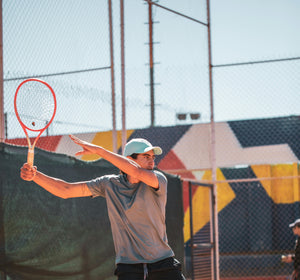Unleashing First Step Power in Tennis
Jul 02, 2025
In tennis, every rally and every point can hinge on a single moment — that first explosive move toward the ball. While much of the spotlight goes to stroke mechanics and endurance, one of the most critical (and often overlooked) elements of elite performance is First Step Power, or the ability to transition instantly from stillness to speed. And behind that speed is not just strength — but also relaxation.
First Step Power is the neuromuscular ability to generate rapid acceleration from a static or semi-static stance. In tennis, it’s the difference between arriving on time or being late to a shot. It’s the athletic skill that gets you to a drop shot, helps you cut off an angle, or recover in time to reset.
Tennis is about movement efficiency under pressure. Players who master their first step gain advantages in court coverage, stroke readiness, point control, and recovery.
One of the most misunderstood elements of speed and quickness is the ability to stay relaxed. Tight, overly-tense muscles create internal resistance, slowing down the rate at which an athlete can react and move. Relaxed muscles can fire more quickly, respond to cues faster, and shift directions with less delay. In elite tennis, reaction speed is often not limited by strength, but by how quickly an athlete can go from relaxed to explosive.

Photo credit: Saeed Basseri via Pexels
Great players appear to “glide” across the court — not because they’re always faster, but because they’re more efficient and relaxed until the moment of action. To train First Step Power (and relaxation), check out these tips:
Reactive Start Drills: Use auditory or visual cues to simulate match-like reactions and encourage quick, relaxed transitions into motion.
Band-Resisted and Unresisted Sprints: Build power output while emphasizing a loose, responsive posture.
Olympic Lift Derivatives (e.g., Power Snatch, High Pull): Develop explosive hip extension with technical precision — only effective when the body isn’t rigid.
Relaxation Drills & Rhythmic Plyometrics: Skipping, bounce drills, and light shadow footwork teach athletes to move with rhythm and flow.
In addition to training, there are several methods to improve the necessary relaxation of the body. Several, which we have used successfully with tennis players at Boca Cryo, are:
Magnesphere: A magnetic resonance device designed to enhance the parasympathetic “rest and digest” response.
Red Light Therapy: Enhances endorphin release through mitochondrial stimulation.
Pulsed Electromagnetic Field (PEMF): Stimulates cellular activity by recharging the cell, enhancing circulation, and returning the cell to a functional, rested state.
In conclusion, First Step Power is more than brute force — it’s the perfect combination of readiness, relaxation, and explosive intent. Tennis players who learn to move from a relaxed posture into controlled aggression not only respond quicker — they dominate space. If you're serious about improving court speed, train not just harder, but smarter: explosive, reactive, and relaxed.
===
Ian Pyka was a two-sport collegiate athlete and three-time All-American who made the Olympic team. Pyka went on to become the strength and conditioning coach at the Florida Panthers and New England Patriots. Pyka currently teaches at FAU's Exercise Science Department and owns Boca Cryo located at 190 Glades Rd., Suite C, in Boca Raton. Photo credit (top): Saeed Basseri via Pexels

